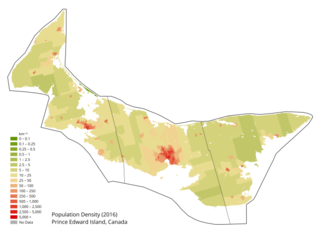
Statistics Canada conducts a country-wide census that collects demographic data every five years on the first and sixth year of each decade. The 2021 Canadian Census enumerated a total population of 36,991,981, an increase of around 5.2 percent over the 2016 figure. Between 2011 and May 2016, Canada's population grew by 1.7 million people, with immigrants accounting for two-thirds of the increase. Between 1990 and 2008, the population increased by 5.6 million, equivalent to 20.4 percent overall growth. The main driver of population growth is immigration and, to a lesser extent, natural growth.

The demographics of Estonia in the 21st century result from historical trends over more than a thousand years, as with most European countries, but have been disproportionately influenced by events in the second half of the 20th century. The Soviet occupation (1944–1991), extensive immigration from Russia and other parts of the former USSR, and the eventual restoration of independence of Estonia, have all had a major effect on Estonia's current ethnic makeup.

Ireland had a population of 5,123,536 at the 2022 census.

The demography of Kenya is monitored by the Kenyan National Bureau of Statistics. Kenya is a multi-ethnic state in East Africa. Its total population was at 47 558,296 as of the 2019 census.

The population of Australia is estimated to be 26,003,200 as of 22 November 2022. Australia is the 55th most populous country in the world and the most populous Oceanian country. Its population is concentrated mainly in urban areas, particularly on the Eastern, South Eastern and Southern seaboards, and is expected to exceed 28 million by 2030.

The United States had an official estimated resident population of 331,893,745 on July 1, 2021, according to the U.S. Census Bureau. This figure includes the 50 states and the District of Columbia but excludes the population of five unincorporated U.S. territories as well as several minor island possessions. The United States is the third most populous country in the world. The Census Bureau showed a population increase of 0.12% for the twelve-month period ending in July 2021, below the world average annual rate of 0.9%. The total fertility rate in the United States estimated for 2021 is 1.664 children per woman, which is below the replacement fertility rate of approximately 2.1.
Kakamega is a town in western Kenya lying about 30 km north of the Equator. It is the headquarters of Kakamega County that has a population of 1,867,579.
The foreign-born population of the United Kingdom includes immigrants from a wide range of countries who are resident in the United Kingdom. In the period January to December 2016, there were groups from 22 foreign countries that were estimated to consist of at least 100,000 individuals residing in the UK.

The hadada ibis is an ibis native to Sub-Saharan Africa. It is named for its loud three to four note calls uttered in flight especially in the mornings and evenings when they fly out or return to their roost trees. Although not as dependent on water as some ibises, they are found near wetlands and often live in close proximity to humans, foraging in cultivated land and gardens. A medium-sized ibis with stout legs and a typical down-curved bill, the wing coverts are iridescent with a green or purple sheen. They are non-migratory but are known to make nomadic movements in response to rain particularly during droughts. Their ranges in southern Africa have increased with an increase in tree cover and irrigation in human-altered habitats.

Alberta has experienced a relatively high rate of growth in recent years, due in large part to its economy. Between 2003 and 2004, the province saw high birthrates, relatively high immigration, and a high rate of interprovincial migration when compared to other provinces. Approximately 81% of the population live in urban areas and only about 19% live in rural areas. The Calgary–Edmonton Corridor is the most urbanized area in Alberta and is one of Canada's four most urban regions. Many of Alberta's cities and towns have also experienced high rates of growth in recent history. From a population of 73,022 in 1901, Alberta has grown to 3,645,257 in 2011 and in the process has gone from less than 1.5% of Canada's population to 10.9%. As of July 1, 2018, Alberta's population represented 11.6% of Canada's total population of 37,058,856 making it the fourth most populated province in Canada. According to the 2018 third quarter report, Alberta's population increased by 23,096 to 4,330,206, the largest increase since the 2014 economic downturn.

Demographics of the province of Prince Edward Island, Canada. According to the 2011 National Household Survey, the largest ethnic group consists of people of Scottish descent (39.2%), followed by English (31.1%), Irish (30.4%), French (21.1%), German (5.2%), and Dutch (3.1%) descent. Prince Edward Island is mostly a white community and there are few visible minorities. Chinese people are the largest visible minority group of Prince Edward Island, comprising 1.3% of the province's population. Almost half of respondents identified their ethnicity as "Canadian." Prince Edward Island is by a strong margin the most Celtic and specifically the most Scottish province in Canada and perhaps the most Scottish place (ethnically) in the world, outside Scotland. 38% of islanders claim Scottish ancestry, but this is an underestimate and it is thought that almost 50% of islanders have Scottish roots. When combined with Irish and Welsh, almost 80% of islanders are of some Celtic stock, albeit most families have resided in PEI for at least two centuries. Few places outside Europe can claim such a homogeneous Celtic ethnic background. The only other jurisdiction in North America with such a high percentage of British Isles heritage is Newfoundland.
African immigration to the United States refers to immigrants to the United States who are or were nationals of modern African countries. The term African in the scope of this article refers to geographical or national origins rather than racial affiliation. Between the Immigration and Nationality Act of 1965 and 2017 the African -born population in the United States grew to 2.1 million people.

Australians, colloquially known as Aussies, are the citizens, nationals and individuals associated with the country of Australia. This connection may be residential, legal, historical or ethno-cultural. For most Australians, several of these connections exist and are collectively the source of their being Australian. Australian law does not provide for a racial or ethnic component of nationality, instead relying on citizenship as a legal status.

The family of Barack Obama, the 44th president of the United States, is a prominent American family active in law, education, activism and politics. Obama's immediate family circle was the first family of the United States from 2009 to 2017, and are the first such family of African-American descent. His immediate family includes his wife Michelle Obama and daughters Malia and Sasha Obama.

Mau Forest is a forest complex in the Rift Valley of Kenya. It is the largest indigenous montane forest in East Africa. The Mau Forest complex has an area of 273,300 hectares.

During Barack Obama's campaign for president in 2008, throughout his presidency and afterwards, there was extensive news coverage of Obama's religious preference, birthplace, and of the individuals questioning his religious belief and citizenship – efforts eventually known as the "birther movement", by which name it is widely referred to across media. The movement falsely asserted Obama was ineligible to be President of the United States because he was not a natural-born citizen of the United States as required by Article Two of the Constitution. Birther conspiracy theories were predominantly held by conservatives and Republicans, as well as racists.

Non-Hispanic whites or Non-Latino whites are Americans who are classified as "white", and are not of Hispanic heritage. The United States Census Bureau defines white to include European Americans, Middle Eastern Americans, and North African Americans. Americans of European ancestry represent ethnic groups and more than half of the white population are German, Irish, Scottish, English, Italian, French and Polish Americans. In the United States, this population was first derived from English settlement of the America, as well as settlement by other Europeans such as the Germans and Dutch that began in the 17th century. Continued growth since the early 19th century is attributed to sustained very high birth rates alongside relatively low death rates among settlers and natives alike as well as periodically massive immigration from European countries, especially Germany, Ireland, England, Italy, Greece, the Netherlands, France and Wales, as well as Poland, Russia, and many more countries. It typically refers to an English-speaking American in distinction to Spanish speakers in Mexico and the Southwestern states. In some parts of the country, the term Anglo-American is used to refer to non-Hispanic white English speakers as distinct from Spanish and Portuguese speakers although the term is more frequently used to refer to people of British or English descent and might include white people of Hispanic descent who no longer speak Spanish.

The 1947 Yogyakarta Dakota accident occurred when a Douglas C-47 Skytrain was carrying medical supplies to the de facto republican government of Indonesia at Yogyakarta which crashed on 29 July 1947.

Many countries and national censuses currently enumerate or have previously enumerated their populations by race, ethnicity, nationality, or a combination of these characteristics. Different countries have different classifications and census options for race and ethnicity/nationality which are not comparable with data from other countries. In addition, many of the race and ethnicity concepts that appear on national censuses worldwide have their origins in Europe or in the views of Europeans, rather than in the views of the locals of these countries.
Kenyan Australians are Australian citizens and residents of Kenyan origin and descent. They may be of indigenous African, European, or Indian heritage.
















